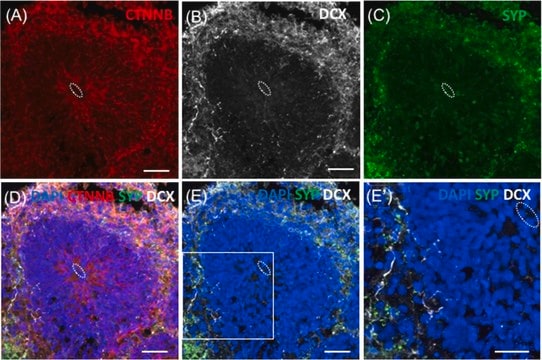おすすめの製品
由来生物
chicken
品質水準
100
200
抗体製品の状態
affinity isolated antibody
抗体製品タイプ
primary antibodies
クローン
polyclonal
精製方法
affinity chromatography
化学種の反応性
mouse, rat
テクニック
immunocytochemistry: suitable
immunohistochemistry: suitable (paraffin)
western blot: suitable
アイソタイプ
IgY
輸送温度
wet ice
ターゲットの翻訳後修飾
unmodified
遺伝子情報
mouse ... Rbfox3(52897)
rat ... Rbfox3(287847)
詳細
NeuN (RNA binding protein fox-1 homolog 3; Fox-1 homolog C) is a RNA-binding protein found exclusively in the nuclei of neuronal cells. It is a member of the evolutionarily conserved Fox-1 family and is mainly involved in splicing of RNA.
特異性
Other homologies: Human (94% sequence homology).
This antibody recognizes the N-terminus of NeuN.
免疫原
Epitope: N-terminus
GST-tagged recombinant protein corresponding to the N-terminus of mouse NeuN.
アプリケーション
Research Category
ニューロサイエンス
ニューロサイエンス
Research Sub Category
ニューロン発生
ニューロン発生
Immunocytochemistry Analysis: A 1:500 dilution from a representative lot detected NeuN in rat E18 cortex cells.
Immunohistochemistry Analysis: A 1:500 dilution from a representative lot detected NeuN in mouse brain, mouse hippocampus, and mouse frontal cortex tissues.
Immunohistochemistry Analysis: A 1:500 dilution from a representative lot detected NeuN in mouse brain, mouse hippocampus, and mouse frontal cortex tissues.
This Anti-NeuN Antibody is validated for use in IHC(P), Western Blotting, ICC for the detection of NeuN.
品質
Evaluated by Western Blot in mouse brain E16 tissue lysate.
Western Blot Analysis: 0.5 µg/mL of this antibody detected NeuN on 10 µg of mouse brain E16 tissue lysate.
Western Blot Analysis: 0.5 µg/mL of this antibody detected NeuN on 10 µg of mouse brain E16 tissue lysate.
ターゲットの説明
~45 kDa observed. Uncharacterized bands appear at ~40 and ~50 kDa in some lysates.
物理的形状
Affinity purified
Purified chicken polyclonal in buffer containing 0.1 M Tris-Glycine (pH 7.4), 150 mM NaCl with 0.05% sodium azide.
保管および安定性
Stable for 1 year at 2-8°C from date of receipt.
アナリシスノート
Control
Mouse brain E16 tissue lysate
Mouse brain E16 tissue lysate
免責事項
Unless otherwise stated in our catalog or other company documentation accompanying the product(s), our products are intended for research use only and are not to be used for any other purpose, which includes but is not limited to, unauthorized commercial uses, in vitro diagnostic uses, ex vivo or in vivo therapeutic uses or any type of consumption or application to humans or animals.
Not finding the right product?
Try our 製品選択ツール.
保管分類コード
12 - Non Combustible Liquids
WGK
WGK 1
引火点(°F)
Not applicable
引火点(℃)
Not applicable
適用法令
試験研究用途を考慮した関連法令を主に挙げております。化学物質以外については、一部の情報のみ提供しています。 製品を安全かつ合法的に使用することは、使用者の義務です。最新情報により修正される場合があります。WEBの反映には時間を要することがあるため、適宜SDSをご参照ください。
Jan Code
ABN91-0.5KL:
ABN91:
試験成績書(COA)
製品のロット番号・バッチ番号を入力して、試験成績書(COA) を検索できます。ロット番号・バッチ番号は、製品ラベルに「Lot」または「Batch」に続いて記載されています。
この製品を見ている人はこちらもチェック
Curt Mazur et al.
JCI insight, 4(20) (2019-10-18)
Intrathecal (IT) delivery and pharmacology of antisense oligonucleotides (ASOs) for the CNS have been successfully developed to treat spinal muscular atrophy. However, ASO pharmacokinetic (PK) and pharmacodynamic (PD) properties remain poorly understood in the IT compartment. We applied multimodal imaging
M E Cahill et al.
Molecular psychiatry, 23(6), 1474-1486 (2017-05-31)
The nucleus accumbens (NAc) is a primary brain reward region composed predominantly of medium spiny neurons (MSNs). In response to early withdrawal from repeated cocaine administration, de novo dendritic spine formation occurs in NAc MSNs. Much evidence indicates that this
Lauren Carr et al.
PloS one, 12(2), e0172736-e0172736 (2017-02-25)
The secreted glycoproteins, Slit1-3, are classic axon guidance molecules that act as repulsive cues through their well characterised receptors Robo1-2 to allow precise axon pathfinding and neuronal migration. The expression patterns of Slit1-3 and Robo1-2 have been most characterized in
Zsofia I Kovacs et al.
Theranostics, 8(17), 4837-4855 (2018-10-04)
Magnetic resonance imaging (MRI)-guided pulsed focused ultrasound (pFUS) combined with microbubbles (MB) contrast agent infusion has been shown to transiently disrupt the blood-brain barrier (BBBD), increasing the delivery of neurotherapeutics to treat central nervous system (CNS) diseases. pFUS interaction with
Luiz Alexandre Viana Magno et al.
The Journal of neuroscience : the official journal of the Society for Neuroscience, 39(17), 3234-3248 (2019-02-21)
Neuromodulation of deep brain structures (deep brain stimulation) is the current surgical procedure for treatment of Parkinson's disease (PD). Less studied is the stimulation of cortical motor areas to treat PD symptoms, although also known to alleviate motor disturbances in
ライフサイエンス、有機合成、材料科学、クロマトグラフィー、分析など、あらゆる分野の研究に経験のあるメンバーがおります。.
製品に関するお問い合わせはこちら(テクニカルサービス)














